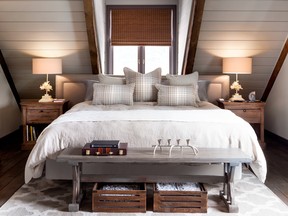
Reviews and recommendations are unbiased and products are independently selected. Postmedia may earn an affiliate commission from purchases made through links on this page.
Article content
Your guide to getting the perfect night’s sleep
Advertisement 2
Article content
With careful planning, the humble sleep zone can transform into a cossetting escape from the pressures of the outside world. This observed, here’s how to better your inner sanctum…
First up, keep yours clearly and exclusively defined as a bedroom, and (where possible) avoid multitasking with ironing boards, tread mills and computers.
In much the same way as a painted or wallpapered accent zone provides focus and personality, so too should a well-dressed bed occupy centre stage in your nocturnal quarters.
Dress your bed as a tactile feast with a soothing mix of soft, cool cottons. Whilst three to five hundred ‘thread count per square inch’ is generally a good barometer of sheet quality, it’s not a guarantee: it’s actually the quality of thread that’s important, rather than the literal amount of threads per square inch.
Article content
Advertisement 3
Article content
A lower count, therefore, may feel comfier if the thread is actually of a higher quality. And, conversely, a higher count may feel less indulgent if the thread quality is lower…
As far as décor goes, avoid bright colours like vivid oranges and zesty yellows, as those shades won’t induce sleep. Neutral, pastel and soft warm shades are eminently more restful.
Opt for warm flooring variants such as wood and carpet, and avoid ceramic tile, marble or granite. There’s little worse than stepping onto a cold floor as the new day begins.
Satisfy your sense of smell with scented candles or good old-fashioned fresh air. Even during winter months, it’s good to air your bedroom for at least half an hour each day.
Which sleeper category are you?
Advertisement 4
Article content
Side sleeper
Best for a side sleeper is a mattress that evenly distributes pressure points along the spine, being that it’s important for side sleepers to keep the back aligned and in a neutral position. We also recommend a higher pillow to keep neck tensions to a minimum.
Back sleeper
Sleeping on one’s back helps evenly distribute body weight. For this category, we recommend a firm mattress to support all body pressure points, and a lower firm pillow to keep the spine naturally positioned.
Stomach sleeper
In this category, cushioned support around the neck and base of the spine will prove helpful. Furthermore, a soft (yet firm) mattress – to let the body sink in whilst supporting lumber regions – will further amplify the comfort quotient.
Advertisement 5
Article content
Being that we spend (up to) a third of our lives asleep, it’s important to choose a good quality mattress. Here are the principal variants…
Inner spring
Bonnell coil: shaped like an hourglass, these inexpensive coils are susceptible to damage, and prone to popping.
Continuous coil: these employ a wire system and hundreds of interconnecting springs. Manufactured to extend mattress life, and favoured by top hotels, they avoid premature sagging.
Pocket coil: independent springs, encased in fabric and foam, provide support for the head, chest and hips. Downsides? They can be expensive, and can ‘dip’ in heavily compressed areas.
Memory foam
These consist of a regular foam layer, on top of which sits the memory foam. Developed using NASA tech’, the comfort layer is generally slimmer than the base layer and designed with heat retaining properties, body contouring ability and, as marketers pronounce, superior support.
Advertisement 6
Article content
Latex foam
This option offers similar support to memory foam, albeit with distinctions: latex is more natural and retains less body heat, making it popular with “hot sleepers” and those who suffer with scent hypersensitivity.
Air beds
Airbeds have come a long way, some versions having the capacity to adjust firmness, independently, at each side.
Waterbeds
Old school options provided limited support and poor ‘motion-cancelling’. Today’s, however, allow firmness control as well as temperature shift on high spec’ models.
Futons
Space saving, these proffer similar support to memory foam and latex mattresses. Constructed using cotton, foam and synthetics, not all are hypoallergenic, so assure yourself of “breathe” quality before investing.
In summation, we suggest spending what you can afford: a mattress should be good for a decade, so do the math’: a $2,000 bed breaks down to $200 per year which, in turn, equates to less than $4 a week. A small price to pay, as we see it, for a perfect night’s sleep?
For more information visit, www.bettersleep.org
Watch for Colin and Justin on Citytv’s Breakfast Television. Find the Colin
and Justin Collection in stores across Canada. Visit www.colinandjustin.tv
Article content
